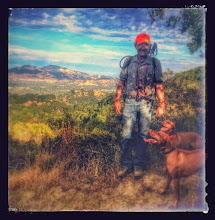In this corner,
1 year - 4 months old,
weighing in at 61 pounds,
24" to top of the shoulders.....
Intact male Hungarian Pointer.............TOBI
 In this corner,
4 years - 2 months old,
weighing in at 60 pounds,
23.5 inches to top of shoulders....
intact male Hungarian Pointer........BAILEY
In this corner,
4 years - 2 months old,
weighing in at 60 pounds,
23.5 inches to top of shoulders....
intact male Hungarian Pointer........BAILEY
Bailey and Tobi have been going on walks in the hills now for six months from time to time. Tobi's owners are first time dog people and are really great with their dog.
About a month ago, on our walks, I started noticing Tobi starting to "test" Bailey. It was the little things an intact male will do to test his new "doghood". I told the owners that one day the two dogs would have to work it out. This type of behavior repeated itself over maybe five walks.
Two weeks ago, on a walk in the hills with Chloe and another female Vizsla, it was the day. I could almost tell from the start that it would be this morning that the testosterone would kick in and things would be settled. I mentioned this to Tobi's owner as the walk began.
After a great 90 minute walk in the Sunol Regional Park it was "put up or shut up" time between Bailey and Tobi.
I'll let Tobi's owner explain: ( I had asked her to put it in her words
)
" In regards to Tobi and Bailey “working it out”…
I had noticed the challenge brewing over the past few walks, so even though you’re never totally prepared, I was sort of waiting for it to happen. I know that Tobi had been challenging Bailey…waiving the stick in front of him and trying to assert his strength. To be honest, I was still worried, but having walked with you and Bailey countless times gave me confidence that Bailey would show Tobi (still the puppy) his place and then back off; not “go in for the kill” so to speak. That is why I did not feel the need to step in. You and I may differ slightly on our opinion of this, but I probably would’ve reacted differently had it been a dog and/or owner that I don’t know. I don’t think I would have been comfortable, or felt the need, to let Tobi work it out with a strange dog. That being said, it was over rather quickly and Bailey backed off as soon as Tobi whimpered…and then they went on their way. Do I trust that all dogs would back off? Unfortunately, no. So I would still be somewhat protective of my dog in an unknown situation."
Just walked with Tobi, Chloe and Bailey last night. First time since. The boys were fine. NO posturing or testing. Just a pack of Hungarian Pointers enjoying the hills on an off-leash walk.
Ain't nature great!




 In this corner,
In this corner, 
 . And I like that the vest looks nothing like a service dog vest, since I don't want anyone to think I'm trying to pass her off for a service dog. I've attached a pic of Lulu in her new vest. I hope it will give me more confidence to work with her in busier places!
. And I like that the vest looks nothing like a service dog vest, since I don't want anyone to think I'm trying to pass her off for a service dog. I've attached a pic of Lulu in her new vest. I hope it will give me more confidence to work with her in busier places! . I like that the vest sends out a message that your dog isn't perfect, but a work in progress!
. I like that the vest sends out a message that your dog isn't perfect, but a work in progress!





